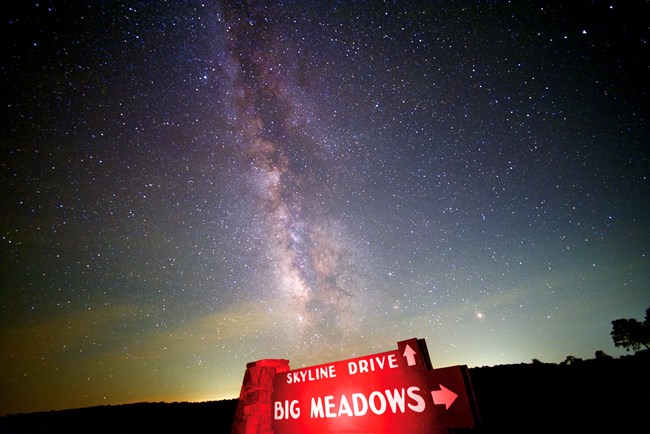
Greg Redfern Big Meadows is a nationally significant cultural landscape. The 440-acre Big Meadows site is situated at milepost 51 on Skyline Drive, directly across from the Harry F. Byrd, Sr. Visitor Center. The site is covered with semi-wooded areas, wetlands, and a large open meadow, providing a variety of scenic landscape views. Big Meadows is easily accessible and a popular destination for stargazing at night and watching butterflies during the day.
When was the last time you were able to experience the awe of seeing a sky full of stars? It can be easy to feel disconnected from, or simply forget about, the beauty and sheer vastness of the cosmos. Notice the band of light stretching above Big Meadows. This is the milky way - the galaxy that contains our solar system! While the sky above Shenandoah National Park may not get as dark as it does in some of the parks in the western or northern United States, the park’s high elevation, combined with relative remoteness from dense urban areas, makes it a great place to look at the stars. Big Meadows is one of the most popular stargazing destinations for hundreds of miles. Night sky parties in the late summer are popular activities for visitors. For these events, interpretive rangers provide telescopes and give talks. Stars appear even more crisp on nights when particulate air pollution is low. Particles of air pollution can create a haze and scatter artificial light, causing the visibility of the stars to dim. Pan around this 360-degree image of the night sky taken during a star party at Big Meadows and learn more about night skies here.
Milkweed leaves show different levels of ozone damage. Can you tell which leaf shows the most ozone damage in the photo gallery below? As plants “breathe” (respire), pollutants enter their leaves. Ozone is a highly reactive molecule, and once inside a leaf, it can damage plant tissues, making it harder for a plant to produce and store food. Ozone also weakens plants, making them less resistant to disease and insect infestation. Older leaves at the base of plants show more injury because they have been exposed to ozone the longest. What does ozone damage look like? Plant leaves can be damaged by frost, insects, or fungus but ozone damage has some characteristic clues that you can look for. Ozone injury starts out as just a few angular spots or “stipples.” These stipples are only visible on top of the leaf. The undersides of leaves remain free of visible injury. In addition, ozone injury does not appear on leaf veins or veinlets. Try finding ozone damage on plants in your area. The best time to look for ozone damage is the later part of the summer season. Also, the stipple areas are quite prominent and may appear dark purple, red, or tan to dark brown, depending upon the plant species. Plants that are highly sensitive to ozone are all around us. There are 60 ozone sensitive species at Shenandoah National Park, including: milkweed, tulip poplar (or yellow poplar), white ash, green ash, sweetgum, virgin’s bower, black locust, wild grape, and black cherry. Ozone is a colorless gas found in the air. Ozone can be beneficial or harmful to people, depending upon where it occurs. “Good” ozone is present naturally in the Earth’s upper atmosphere, 10–30 miles above the Earth’s surface. This ozone shields the Earth’s surface from the sun’s ultraviolet rays and keeps Earth’s temperature just right for humans to live. Harmful ozone forms closer to the Earth’s surface when air pollutants from cars, power plants, and chemical plants react in the presence of sunlight. Ozone pollution is more likely to form during warmer months. |
Last updated: February 25, 2019
